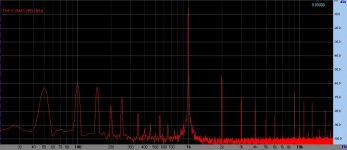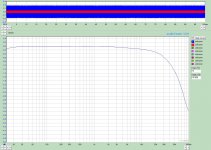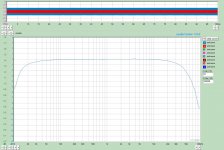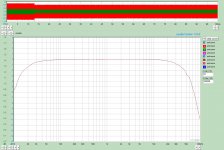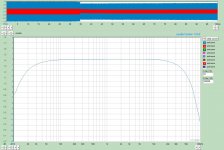I don't know how far afield of your original track you want to go but looking at the cathode follower drivers and feedback and your nice, flexible looking breadboard made me wonder if you've seen Frank Blöhbaum's articles in Linear Audio.(Vol.6 and 8) In the second article he illustrates an A2 power amp design.
I figure it worth mentioning as his ECL113 preamp and UCL11 one tube Power MTA circuits from those articles really impress. Worth a poke or at least a look if you have the time.
(Did you make those turret socket boards, by the way ? They look a nice design.)
I figure it worth mentioning as his ECL113 preamp and UCL11 one tube Power MTA circuits from those articles really impress. Worth a poke or at least a look if you have the time.
(Did you make those turret socket boards, by the way ? They look a nice design.)
Hi Hearinspace - I had not seen the article, let me take a look, thanks for the recommendation! Don't want to venture too far off of the work I've done, but it never hurts to have more ideas floating around.
45's idea about two triodes in cascade got me thinking...
Up to this point I had thought I would need a pentode to reach my output Z goal. With an open-loop gain of 115 on the EF37A input, I was able to achieve an output Z of ~1.5ohm, better than I had hoped for. At this point the concern is only of the distortion of the amplifier, so if I could achieve comparable gain at lower distortion, that would be a win.
I wondered if rather than cascade, I could find a high mu, high Rp, highly linear triode to do the job. I found the 6SF5. Mu of 100, Rp 66K, very nice linear curves.
From the datasheet
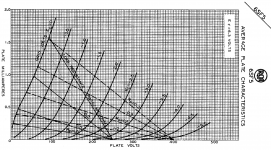
From VinylSavor
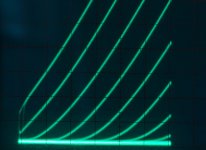
And an example of what could be done, either CCS or gyrator load. Considering the output impedances I have thrown at the 6BX7 CF, 6SF5 is a piece of cake, however output can be taken from the source of the DN2540 as well.
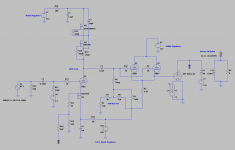
By the math, this circuit would still achieve an output Z of ~2.1ohm. LTSpice says 0.3% THD at 1W, and we all know the simulation is always right 😛
I will grab a few of these, trace some curves, and give it a try.
Up to this point I had thought I would need a pentode to reach my output Z goal. With an open-loop gain of 115 on the EF37A input, I was able to achieve an output Z of ~1.5ohm, better than I had hoped for. At this point the concern is only of the distortion of the amplifier, so if I could achieve comparable gain at lower distortion, that would be a win.
I wondered if rather than cascade, I could find a high mu, high Rp, highly linear triode to do the job. I found the 6SF5. Mu of 100, Rp 66K, very nice linear curves.
From the datasheet

From VinylSavor

And an example of what could be done, either CCS or gyrator load. Considering the output impedances I have thrown at the 6BX7 CF, 6SF5 is a piece of cake, however output can be taken from the source of the DN2540 as well.

By the math, this circuit would still achieve an output Z of ~2.1ohm. LTSpice says 0.3% THD at 1W, and we all know the simulation is always right 😛
I will grab a few of these, trace some curves, and give it a try.
The 6SF5 is very nice indeed. One day I brought a bunch of RCAs to my friend Ale and after we saw those nicely linear curves on his curve tracer, he developed a gyrator for it...some time after:
6SF5 – Bartola(R) Valves
6SF5 – Bartola(R) Valves
If Ale is pleased with it, I may be on the right track, glad to see you collaborated 🙂 I think this will work out well, I like the simplicity, hopefully will have a pair to test by next weekend.
I remembered seeing 12AX7 w/CCS load distortion performance from SY years ago and found the thread: Cathode Degeneration with CCS plate load- My Mistake
I thought it would be good to compare with your measurements on the 6SF5 when you make them, in case one is significantly better than the other.
I thought it would be good to compare with your measurements on the 6SF5 when you make them, in case one is significantly better than the other.
Fantastic, thanks SpreadSpectrum. There are some other high mu triodes that are probably worth a look too. I was able to find a gentleman local to me with some metal 6SF5, might be able to try this out in the next day or two.
I bought several 6SF5s for peanuts, mostly the GT with glass bulb RCA old print...directly from WWII era in an incredibly mint condition in original boxes, because I found that the price for NOS 12AX7/ECC83's was exaggerate already 10-15 years ago. Likely this was (and is) due to the fact that this tube is also used in 99% of valve guitar amps. I wanted to have a good high gain triode in my inventory.
I soon found oud that in classic applications with resistive load the 6SF5 can give up to 40% more output for the same distortion. There might be some ECC83's that can be equivalent but that's the problem.....
That's why I also decided to take them on a trip to London and see how they look on the curve tracer. With CCS/gyrator loads the difference on average will be likely less but I think the 6SF5 still has the edge also for other aspects.
The 6SF5, at least from what I have been able to find, only exists in one construction. This makes matching really easier. There might be some minor differences about the shape of the mica spacer and getter style but that is really it.
The 12AX7/ECC83 instead exists with different plate styles and they are not all the same when extreme performance is the goal. Finding truly balanced double triodes is more difficult than cross-matching a pair.....if you are looking for balanced ECC83 price goes up, of course.
Last but not least, a matched pair 6SF5s by any US top brand (I think they were mostly made by RCA) + 2 sockets is significantly less expensive than a single current production 12AX7 that has been decently tested and selected + its socket.
In the end, one trades the compact solution offered by the double triode with some more flexibility and lower cost.
Another great candidate is the 6SQ7. This contains 2 duplex diodes, too. However this is more expensive than the 6SF5.
Surely the metal variant was copied and produced by the Chinese too. I have no idea about the Chinese SQ7. It might be as good or not....
Then there are the types with mu=70, like the 6Q7, but as you are looking for higher gain they might be less interesting for this application.
Regarding the simple cascoded CCS/gyrator choice....I think the gyrator is superior. It generally performs better when a wide frequency range is considered and has the double output option (i.e. SE + active load or mu-follower style output).
Gyrator + diode bias (led or SiC).
I soon found oud that in classic applications with resistive load the 6SF5 can give up to 40% more output for the same distortion. There might be some ECC83's that can be equivalent but that's the problem.....
That's why I also decided to take them on a trip to London and see how they look on the curve tracer. With CCS/gyrator loads the difference on average will be likely less but I think the 6SF5 still has the edge also for other aspects.
The 6SF5, at least from what I have been able to find, only exists in one construction. This makes matching really easier. There might be some minor differences about the shape of the mica spacer and getter style but that is really it.
The 12AX7/ECC83 instead exists with different plate styles and they are not all the same when extreme performance is the goal. Finding truly balanced double triodes is more difficult than cross-matching a pair.....if you are looking for balanced ECC83 price goes up, of course.
Last but not least, a matched pair 6SF5s by any US top brand (I think they were mostly made by RCA) + 2 sockets is significantly less expensive than a single current production 12AX7 that has been decently tested and selected + its socket.
In the end, one trades the compact solution offered by the double triode with some more flexibility and lower cost.
Another great candidate is the 6SQ7. This contains 2 duplex diodes, too. However this is more expensive than the 6SF5.
Surely the metal variant was copied and produced by the Chinese too. I have no idea about the Chinese SQ7. It might be as good or not....
Then there are the types with mu=70, like the 6Q7, but as you are looking for higher gain they might be less interesting for this application.
Regarding the simple cascoded CCS/gyrator choice....I think the gyrator is superior. It generally performs better when a wide frequency range is considered and has the double output option (i.e. SE + active load or mu-follower style output).
Gyrator + diode bias (led or SiC).
Last edited:
Nice find, 45, and noted on the equivalent performance of the miniature dual triodes, thanks for the information. I have used gyrator and CCS, I view as voltage vs. current regulated load, the mu output of the cascode CCS can be taken too for low output impedance. I will likely try both and see what suits best, but will try the CCS first for convenience. I think I designed some gyrator PCBs at some point, but the layout needs to be improved.
In terms of availability and diversity of construction, very interesting is the 6F5, grid pin moved to top cap, but otherwise electrically equivalent to the 6SF5. This type has a wide diversity of makes and shapes, with European and Russian equivalents. They are also more widely available it seems. The grid may be more prone to noise pickup, of course.
I am purchasing some metal can 6SF5 later today from a seller local to me and will try them in circuit. If the results are good, I will likely try the 6F5 as well. I am a sucker for those coke bottle shaped triodes 🙂
One thing I am wary of - similar to the CCS modified pentode - is the 6SF5 / 6F5 with active load being too linear, with H3 of the 801A creeping above H2, we will see.
In terms of availability and diversity of construction, very interesting is the 6F5, grid pin moved to top cap, but otherwise electrically equivalent to the 6SF5. This type has a wide diversity of makes and shapes, with European and Russian equivalents. They are also more widely available it seems. The grid may be more prone to noise pickup, of course.
I am purchasing some metal can 6SF5 later today from a seller local to me and will try them in circuit. If the results are good, I will likely try the 6F5 as well. I am a sucker for those coke bottle shaped triodes 🙂
One thing I am wary of - similar to the CCS modified pentode - is the 6SF5 / 6F5 with active load being too linear, with H3 of the 801A creeping above H2, we will see.
Last edited:
Well euro21, I have a new use for 841 in hybrid headphone amp 😀
But at the operating point, plate resistance of the 801A is 3.3K working into 5K load of the Sowter transformers. With 190ohm DCR primary and 0.5ohm secondary, makes for a damping ratio of 1.3:1 without feedback. Also with high output impedance, HF extension suffers due to transformer parasitics. With feedback, damping ratio is >3:1 with full bandwidth, but requires a high-gain VAS. I tried the 841 VAS stage with the 11K Lundahl, but the parasitics were too great with significant HF rolloff, very audible, and poor damping. Maybe I would have had better luck with a different transformer.
But at the operating point, plate resistance of the 801A is 3.3K working into 5K load of the Sowter transformers. With 190ohm DCR primary and 0.5ohm secondary, makes for a damping ratio of 1.3:1 without feedback. Also with high output impedance, HF extension suffers due to transformer parasitics. With feedback, damping ratio is >3:1 with full bandwidth, but requires a high-gain VAS. I tried the 841 VAS stage with the 11K Lundahl, but the parasitics were too great with significant HF rolloff, very audible, and poor damping. Maybe I would have had better luck with a different transformer.
The HF rolloff originated in the output stage, RC formed by high Rp of 801A and capacitance of the output transformer. Bandwidth in the 841 with mu output was no problem!
I hope you are have been working out euro21, with six filament transformers, that is a monster! I am sure it sounds great, how is matching 801A for PSE?
"how is matching 801A for PSE?"
Simple method: collect tubes for decades. 😛
Few bunch of -measured good- tubes, 4 closed (at least Ua, Ia, gm in the desired operating point) pair. :-(
Simple method: collect tubes for decades. 😛
Few bunch of -measured good- tubes, 4 closed (at least Ua, Ia, gm in the desired operating point) pair. :-(
Oh, no ... the breadboarded PSU only 1.5-2 m2. 😛ppwith six filament transformers, that is a monster!
It still "ready to boxing" state in my workshop, but I didn't find enough large box. 🙂
Oh, no ... the breadboarded PSU only 1.5-2 m2. 😛pp
It still "ready to boxing" state in my workshop, but I didn't find enough large box. 🙂
Could go custom! Then the box is as big as you please 😀
Got the 6SF5, here are the curves, Sylvania-made metal can type.
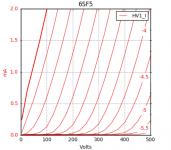
Doesn't get much more linear than that, plate resistance 66.8K, mu 100.
I have the circuit all ready for them, cascode CCS set to 1mA, will post some measurements soon 😉
CCS loaded 6SF5 circuit is up and running. The 6SF5 is biased at 225V 1mA. Given the lower gain, I reduced the feedback fraction slightly to maintain a 2Vrms input sensitivity.
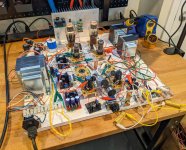
Here are the measurements.
Output Z: 1.76ohm
THD at 100mW into 8ohm
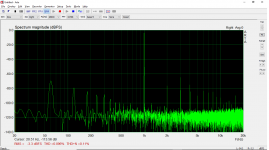
THD at 500mW into 8ohm
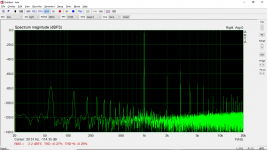
THD at 1W into 8ohm
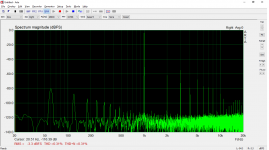
THD at 2W into 8ohm
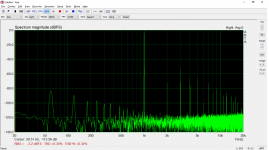
THD at 4W into 8ohm
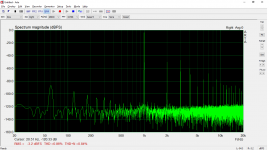
Frequency response
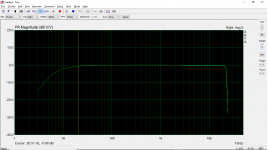
A few observations...
Yes, the harmonic profile is H3 dominant, as I had suspected. I think the reality is, as SpreadSpectrum observed in another thread, the 801A in A2 is going to generate a significant amount of H3. The 6SF5 is highly linear, coupled with an active load, it is going to generate very little H2, so I think the spectrum is the result of this pairing.
Now with that being said, subjectively, I do not hear the harsh treble I attributed to an H3 dominant harmonic spectrum in the past. Maybe tastes are changing, maybe there were other factors in play, maybe the odd harmonics are low enough at normal listening volumes that they do not adversely affect the sound. In any case, I am considering moving forward with this as clarity and bass dynamics are absolutely stellar.
The alternative is to attempt to manufacture H2 at the cost of gain in an attempt to mask the higher order harmonics, perhaps by decreasing the value of the 6BX7 grid resistor or using a resistive load on the 6SF7. Adding distortion to combat another seems an exercise in insanity...
In every other way, the marks are met and I do think the sound is quite good, odd harmonic profile notwithstanding.

Here are the measurements.
Output Z: 1.76ohm
THD at 100mW into 8ohm

THD at 500mW into 8ohm

THD at 1W into 8ohm

THD at 2W into 8ohm

THD at 4W into 8ohm

Frequency response

A few observations...
Yes, the harmonic profile is H3 dominant, as I had suspected. I think the reality is, as SpreadSpectrum observed in another thread, the 801A in A2 is going to generate a significant amount of H3. The 6SF5 is highly linear, coupled with an active load, it is going to generate very little H2, so I think the spectrum is the result of this pairing.
Now with that being said, subjectively, I do not hear the harsh treble I attributed to an H3 dominant harmonic spectrum in the past. Maybe tastes are changing, maybe there were other factors in play, maybe the odd harmonics are low enough at normal listening volumes that they do not adversely affect the sound. In any case, I am considering moving forward with this as clarity and bass dynamics are absolutely stellar.
The alternative is to attempt to manufacture H2 at the cost of gain in an attempt to mask the higher order harmonics, perhaps by decreasing the value of the 6BX7 grid resistor or using a resistive load on the 6SF7. Adding distortion to combat another seems an exercise in insanity...
In every other way, the marks are met and I do think the sound is quite good, odd harmonic profile notwithstanding.
mhh...I still think your main distortion generator is the cathode follower which works into a non-linear load from zip.A few observations...
Yes, the harmonic profile is H3 dominant, as I had suspected. I think the reality is, as SpreadSpectrum observed in another thread, the 801A in A2 is going to generate a significant amount of H3. The 6SF5 is highly linear, coupled with an active load, it is going to generate very little H2, so I think the spectrum is the result of this pairing.
To be certain you should try a good source follower, for our peace of mind.....😀
Now with that being said, subjectively, I do not hear the harsh treble I attributed to an H3 dominant harmonic spectrum in the past. Maybe tastes are changing, maybe there were other factors in play, maybe the odd harmonics are low enough at normal listening volumes that they do not adversely affect the sound. In any case, I am considering moving forward with this as clarity and bass dynamics are absolutely stellar.
Why should you? The level of distortion now is low. No one has the sensitivity to hear that distortion level, especially with relatively efficient speakers like yours that are around 90-91 dB/1W (by memory).
I would not do that.The alternative is to attempt to manufacture H2 at the cost of gain in an attempt to mask the higher order harmonics, perhaps by decreasing the value of the 6BX7 grid resistor or using a resistive load on the 6SF7. Adding distortion to combat another seems an exercise in insanity...
In every other way, the marks are met and I do think the sound is quite good, odd harmonic profile notwithstanding.
Indeed that's the way to make a decision when unwanted effects (distortion) get small. Forget the spectra....if your primary goal is to build the amp to effectively use it for listening to music.
Last edited:
- Home
- Amplifiers
- Tubes / Valves
- 801A in Single-Ended A2 - Design and Build
